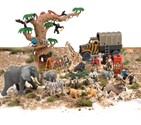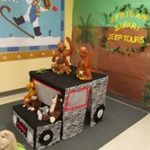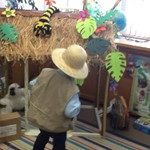I traveled to South Africa last December and was really excited to go on a safari – watch the animals in their habitat, and how they interact with one another. It has been a dream of mine since I was a little girl. More than anything, I wanted to take my own children to see it, and when they could not come, we decided to wait until we could all do it together on another occasion.
In looking for interesting activities for your children, I found this site which offers live safaris hosted by experts in real time. You can even ask them questions as you go! It is the perfect way to spend a rainy afternoon and see a little bit of our beautiful planet, at least until we can go again in person one day.
So, next rainy day, why not get ready to go on a safari. Pack a lunch, dress accordingly, bring a notebook to take notes and draw what you see, bring a camera to capture the animals, and settle into your family room sofa (which we are now pretending is a jeep) to go along for the ride!
We will certainly try it at our CEFA Early Learning schools when we study the animals of Africa. Please share with me how you did it at your house (pictures too, if you dare!) The best part of this home safari is you can pause and start the video as many times as you want to look at an animal in particular, or a scene. I bet you’re going to love it so much that if and when you go on a real African safari, you will wish that the zebras had a pause button too!
It is beginning to get warm in South Africa, so go on, take a virtual trip in the sun!
Best Ages for This Activity
One to five
How to Make It
You will need:
- A computer, tablet or smart TV
- This link
- Your best khakis to wear on your safari – optional
- A picnic and snacks (remember not to feed the animals) – optional
- Binoculars – optional
- A notepad (for notes and drawings)
- A camera or phone (to take photos of the animals that can then be glued to the notepad afterward).
- A card for your child to find the animals while on the safari (I included one here)
Let’s Get Started!
- View the video first to make sure that it will be of interest to your child. If so;
- Invite your child to go on a (pretend) Safari (the more you get into the role-play, the more dramatic play opportunities for your child. Get into your safari clothes (khakis or even camouflage clothes, binoculars, cameras, etc.)
- Turn on the video
- Comment on the animals you see as the video is playing, ask questions, take photos (yes, of your TV screen), listen to the sounds that the animals make, roar like a lion, run like a gazelle – whatever you feel like doing.
Learning Opportunities
Children will learn about our natural world in this activity, especially, about how animals live in the wild, and about animals from Africa. They will learn S.T.E.M. as they use technology to learn about the world, and natural science. Also, because of all the trouble you went into to get into character, they will have an opportunity for dramatic play. If you explore new vocabulary, they will learn literacy. Plus, they will learn that grown-ups too can pretend play.
Extended Learning Opportunities
For the next few weeks, learn about animals that live in Africa using an atlas, books or the internet (check this link here).
- Print the poster of African animals included here and hang it in your child’s room so you can study the animals together, talk about them according to your child’s interests. The point is not to memorize every animal’s data, it is to develop in your child a curiosity about the natural world, and to open the conversation so your child can ask questions about what really interests them about the safari experience (for example, one child might be fascinated with how fast each animal can run, while another might want to know what they eat, and another how large or small each animal is, or your child might be interested in absolutely all of these things, it depends.) go with the interests of your child, explore the world through their eyes, and enrich it where you can. The poster can act as a conversation starter.
- Use the notebook you started for your child to gather all the information they are learning. For instance, they might want to glue the photos of all the animals on it, then write below what they learned about them, then also try drawing them. This extension of the activity is excellent for teaching vocabulary and S.T.E.M. (particularly natural science and math) as well as reading and writing
- Incorporate math into the activity by actually measuring (on your floor or on your wall, with painter’s tape or string) how tall each animal is, and comparing them, organizing them by height, seeing how much room they would take up in your house (“could we have a rhinoceros in our living room? Let’s measure how much room they would take!”; or “how many lions could fit in our bathtub?”; or “would a giraffe fit through the door if we invited it in the house?”)
- Another math activity would be to see how fast each animal is, and try to run as fast as they do (use a chronometer or your phone timer)
- Invite your child to learn about Africa, its culture, its history, its geography, its people and everything your child wants to know! Show them on the globe where it is, what bodies of water surround it, where the animals live mostly, etc. you can use some of the books I suggested below for this. Culture immersion is something we teach at our CEFA Early Learning schools.
- Another excellent activity for dramatic play, creativity, problem-solving, reasoning, literacy, S.T.E.M. and natural sciences is to invite one of the animals to live with you for a day or two. To help your child conceptualize it, try giving them the actual animal they choose to carry around, like a stuffed animal or a figurine of one. You most likely have one of these around the house. Take the animal with you all day long – to breakfast, lunch and dinner (“what does your lion eat?” “how many times does your lion eat each day? Is it as many times as you? Is it less than once a day? Why?”) and in each scenario, figure out what your animal needs (this is where google, an encyclopedia or a book come in to save us!) take the animal to sleep with you (“where does your lion like to sleep? On top of a hill? In a cave? In a pile of grass? Do they get cold? Do they use a blanket like you? Let’s find out!”) and to the bath (“does your lion use a shower? Does he use a bath? How does he get clean? Where does he get clean? Does he brush his teeth? Does he brush his mane? Etc.) – your child will learn about the animal and draw comparisons between a wild animal’s lifestyle and their own. Next time, you can invite a different “animal” for a day and do the same.
- Draw or paint African animals in their natural habitat for writing and visual arts.

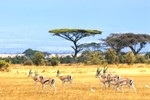
- Invite your child to add to their notebook, under each animal, pictures of parents and their babies. This fascinates young children. You can also compare sizes (birth to full grown) for an added math Talk about how long babies stay close to their moms, and how long until they are independent. This is a wonderful natural science activity and also teaches empathy. There are plenty of videos online that teach you about the animals and show you real footage, just screen them first to make sure you don’t show your child something they are not ready to see (like a gazelle being ripped apart by a couple of lions.)
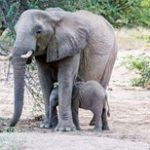

With your child, build a safari or a jungle for them to play in or with, in their room. It does not have to be professional, just anything you have around the house or anything you can build or draw to stir their imagination! You can also build it out of lego together! Here’s a set
